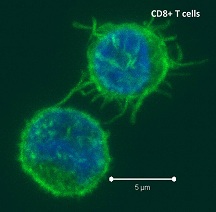 Negative regulatory CD4 T cells are well characterized and highly studied. However their CD8 counterparts are not well defined, particularly in humans. Regulatory CD8 T cells suppress activated CD4 T cells and have proposed roles in various human diseases including multiple sclerosis, ovarian carcinoma and infection with HIV, and many subsets have been described using various markers. In a recent issue of PLoS One, Hu et. al, describe a population of CD3+CD8+CD161−CD56+ T cells within human peripheral blood mononuclear cells (PBMC) that exhibit a cytolytic negative regulatory function.
Negative regulatory CD4 T cells are well characterized and highly studied. However their CD8 counterparts are not well defined, particularly in humans. Regulatory CD8 T cells suppress activated CD4 T cells and have proposed roles in various human diseases including multiple sclerosis, ovarian carcinoma and infection with HIV, and many subsets have been described using various markers. In a recent issue of PLoS One, Hu et. al, describe a population of CD3+CD8+CD161−CD56+ T cells within human peripheral blood mononuclear cells (PBMC) that exhibit a cytolytic negative regulatory function.
This group previously published a study where they isolated CD8 T cell clones that were able to lyse autologous T cell receptor (TCR) activated CD4 T cells (Hu et al., 2011). Surface marker characterization of these regulatory CD8 T cell clones by flow cytometry found that they expressed CD56, CD62L and CD95 but not CD16, CD161, CXCR4 and CCR7.
Because CD161 and CD56 are generally co-expressed markers in NK and NKT cells but are not expressed on conventional CD8 T cells, the authors reasoned that these markers (CD161−CD56+) in addition to CD3 and CD8 may provide a robust way to distinguish this population of regulatory CD8 T cells from conventional CD8 T cells, NK cells, and NKT cells by flow cytometry. Thus in the PLoS One study, the author’s objectives included identification and characterization of this subset of regulatory CD8 T cells in normal human PBMC.
A population of CD3+CD8+CD161−CD56+ regulatory CD8 T cells were identified in PBMC and compared with conventional CD8 T cells (CD3+CD8+CD161−CD56–) and NKT cells (CD3+CD8+CD161+CD56+). On average, regulatory CD8 T cells occurred at a frequency of 3.2% of total CD8 T cells. Regulatory CD8 T cells resembled terminally differentiated effector CD8 cells by expressing CD45RA, but not CD45RO or CCR7, and had lower levels of CD62L and CD27. NKT cells in contrast expressed CD45RO. For a further discussion of expression of CD45RA, CD45RO, CCR7, CD62L, and CD27 by naïve, central memory, effector memory, and terminally differentiated effector T cell populations, I refer you to a previous post.
Expression of these and numerous other markers were examined in resting and activated regulatory CD8 T cells including CD127, CD25, CD28, CD69, CD94, NKG2a, CD8β, and TCRVα24, and the details can be found in the paper. Additionally, morphological examination of these cells revealed a larger cytoplasm with some granules, and an irregular nucleus, characteristic of activated T cells and NK cells, but not resting conventional CD8 T cells.
Finally the authors demonstrated that activated CD56+ but notCD56–, CD8+CD161– T cells could lyse autologous and allogeneic activated CD4 T cell targets, similarly to the regulatory CD8 T cell clones previously described.
Thus, this study describes the identification of a CD161−CD56+ CD8 T cell subset capable of negative regulatory function: cytolysis of activated CD4 T cells. Many questions remain for further exploration of this interesting population of cells. Multiple other negative regulatory CD8 T cell subsets have been described including FoxP3+ CD8 T cells. Determining the differences between various regulatory CD8 T cell subsets regarding marker expression and function should be addressed. Additionally, the CD8 T cell clones previously described by this group expressed IFN-gamma following activation. As these negative regulatory CD8 T cells also phenotypically resemble terminally differentiated effector CD8 cells, these populations should be directly functionally compared in future studies.
Identification of Cytolytic CD161(-)CD56(+) Regulatory CD8 T Cells in Human Peripheral Blood. Hu D, Weiner HL, Ritz J. PLoS One. 2013;8(3):e59545. doi: 10.1371/journal.pone.0059545. Epub 2013 Mar 19.
A clonal model for human CD8+ regulatory T cells: unrestricted contact-dependent killing of activated CD4+ T cells. Hu D, Liu X, Zeng W, Weiner HL, Ritz J. Eur J Immunol. 2012 Jan;42(1):69-79. doi: 10.1002/eji.201141618. Epub 2011 Nov 28.

